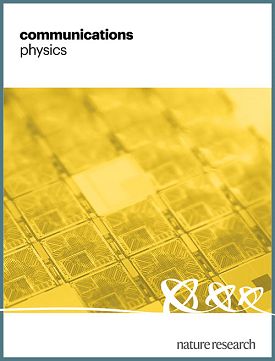Channel-resolved wavefunctions of transverse magnetic focusing
IF 5.8
1区 物理与天体物理
Q1 PHYSICS, MULTIDISCIPLINARY
引用次数: 0
Abstract
Transverse magnetic focusing (TMF) is a staple technique in mesoscopic physics, used to study quasiparticles in a manner akin to mass spectrometry. However, the quantum nature of TMF has been difficult to appreciate due to several challenges in addressing the wavelike properties of the quasiparticles. Here, we report a numerical solution and experimental demonstration of the TMF wavefunction for the multichannel case, implemented using quantum point contacts in a two-dimensional electron gas. The wavefunctions could be understood as transverse modes of the emitter tracing a classical trajectory, and the geometric origins of multichannel effects were easily intuited from this simple picture. We believe our results may correspond to a near-field regime of TMF, in contrast to a far-field regime where the well-established semiclassical results are valid. Based on disorder analysis, we expect these results will apply to a wide range of realistic devices, suggesting that spatially coherent features even at the wavelength scale can be appreciated from TMF. Transverse magnetic focusing (TMF) has been widely used in mesoscopic physics, yet its quantum mechanical properties remain difficult to fully appreciate. Here, the authors present a numerical solution of TMF, analysed with channel-resolution and compared against experimental data, to expose the multichannel signatures of the TMF wavefunction.

横向磁聚焦的通道分辨波函数
横向磁聚焦(TMF)是介观物理学中的一项主要技术,用于研究准粒子,类似于质谱法。然而,由于在处理准粒子的波状性质方面的几个挑战,TMF的量子性质一直难以理解。在这里,我们报告了多通道情况下TMF波函数的数值解和实验演示,使用二维电子气体中的量子点接触实现。波函数可以理解为发射器沿经典轨迹的横模,从这幅简单的图中很容易直观地看出多通道效应的几何起源。我们相信我们的结果可能对应于TMF的近场状态,而不是远场状态,在远场状态下,已建立的半经典结果是有效的。基于失序分析,我们期望这些结果将适用于广泛的现实器件,这表明即使在波长尺度上也可以从TMF中获得空间相干特征。横向磁聚焦(TMF)在介观物理中得到了广泛的应用,但其量子力学性质仍然难以完全理解。在这里,作者提出了一个TMF的数值解,用通道分辨率进行了分析,并与实验数据进行了比较,揭示了TMF波函数的多通道特征。
本文章由计算机程序翻译,如有差异,请以英文原文为准。
求助全文
约1分钟内获得全文
求助全文
来源期刊

Communications Physics
Physics and Astronomy-General Physics and Astronomy
CiteScore
8.40
自引率
3.60%
发文量
276
审稿时长
13 weeks
期刊介绍:
Communications Physics is an open access journal from Nature Research publishing high-quality research, reviews and commentary in all areas of the physical sciences. Research papers published by the journal represent significant advances bringing new insight to a specialized area of research in physics. We also aim to provide a community forum for issues of importance to all physicists, regardless of sub-discipline.
The scope of the journal covers all areas of experimental, applied, fundamental, and interdisciplinary physical sciences. Primary research published in Communications Physics includes novel experimental results, new techniques or computational methods that may influence the work of others in the sub-discipline. We also consider submissions from adjacent research fields where the central advance of the study is of interest to physicists, for example material sciences, physical chemistry and technologies.
 求助内容:
求助内容: 应助结果提醒方式:
应助结果提醒方式:


